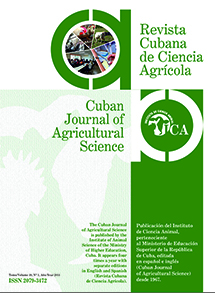Humic substances benefiting the development of Arachis pintoi cv. Amarillo MG 100 (forage peanut) cultivated on degraded soil
Main Article Content
Abstract
Humic substances are increasingly being used as biostimulants and may even benefit the development of forage peanut (Arachis pintoi cv. Amarillo MG 100), a promising species for the recovery of degraded pastures. The study aimed to evaluate different concentrations of humic substances extracted from vermicompost from cattle manure on growth and nutrient content in forage peanut plants inoculated with Bradyrhizobium spp. The experiment was carried out in a greenhouse, in a randomized block design, with five concentrations of humic substance and five replications. The shoot dry matter, root dry matter, the number of nodules, the content of macronutrients in the shoot, total chlorophyll content, chlorophyll a/b ratio, and quantum efficiency of the photosystem II were evaluated. The addition of humic substances increased the yield and nutrient accumulation of the forage peanut plants. The shoot dry matter responded in a quadratic manner to the addition of humic substances. The concentration of 40 mg L-1 of C increased 45.85% of the number of nodules compared to the control. There were improvements in efficiency of the photosystem II and the accumulation of nitrogen, potassium, calcium and magnesium by up to 12 % (37.1 to 41.5 mg pot-1), 8.6 % (35.3 to 38.3 mg pot-1), 13.5 % (21.8 to 24.7 mg pot-1) and 7.5 % (9.8 to 10.53 mg pot-1), respectively, in the shoot with the humic substances application, except for the phosphorus accumulation.
Keywords: biostimulants, nodulation, soil of low fertility, photosystem II, Bradyrhizobium
Article Details
Those authors that have publications with this journal accept the following terms:
1. They will retain their copyright and guarantee the journal the right of first publication of their work, which will be simultaneously subject to the License Creative Commons Attribution-NonCommercial 4.0 International (CC BY-NC 4.0) that allows third parties to share the work whenever its author is indicated and its first publication this journal. Under this license the author will be free of:
- Share — copy and redistribute the material in any medium or format
- Adapt — remix, transform, and build upon the material
- The licensor cannot revoke these freedoms as long as you follow the license terms.
Under the following terms:
- Attribution — You must give appropriate credit, provide a link to the license, and indicate if changes were made. You may do so in any reasonable manner, but not in any way that suggests the licensor endorses you or your use.
- NonCommercial — You may not use the material for commercial purposes.
- No additional restrictions — You may not apply legal terms or technological measures that legally restrict others from doing anything the license permits.
2. The authors may adopt other non-exclusive license agreements to distribute the published version of the work (e.g., deposit it in an institutional telematics file or publish it in a monographic volume) whenever the initial publication is indicated in this journal.
3. The authors are allowed and recommended disseminating their work through the Internet (e.g. in institutional telematics archives or on their website) before and during the submission process, which can produce interesting exchanges and increase the citations of the published work. (See the Effect of open access).
